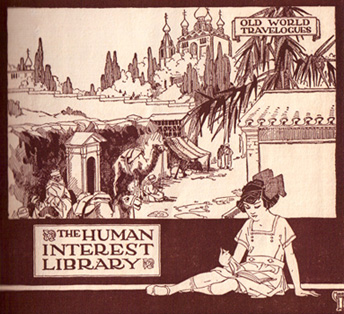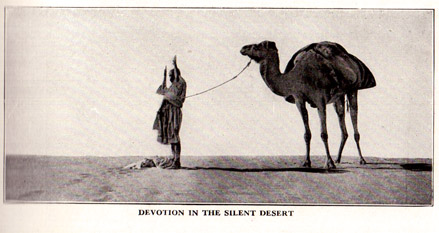
Exactly 90 years ago in 1921 a four-volume set of encyclopedia-like human interest books was published as The Human Interest Library: Visualized Knowledge by Midland Press in Chicago. All four volumes ended up in my family’s library, but my favorite is the fourth volume entitled Old World Travelogues. Here is how the volume begins:
It was a saying of Lord Bacon that “History maketh one wise.” Perhaps this is not universally true, but one can scarcely traverse the history and geography of the Old World with its deeds of heroism, picturesque scenes and peoples, splendid buildings, or hallowed places, without having become wiser and better, as well as having enjoyed many an hour of keen pleasure. With the most interesting of guides, we visit splendid cities, historic rivers of scenic beauty or castle-lined banks; monument-covered battle-fields, or the haunts of poets and cavaliers.

The image above is at the head of the article on “The Sahara and its Inhabitants” (pp. 95-103). If this history is intended to make the reader wiser, it is a bleak premise indeed. Here is how the desert is represented:
The desert is a dreary, monotonous place, life there has a great sameness, there is little physical work to be done, little cooking is required and there is little to engage the attention of men. Under these circumstances men think much on some of the deeper problems of life, two of the great religions of the earth were developed in deserts. The art of the desert is influenced by the surroundings and this is also true of the literature. Deserts are great barriers and people, who live there are apt to be isolated, they are shut off from the rest of the world.
They are therefore backward in the development of culture, they have primitive tools and weapons. Old customs, ancient styles of dress, prevail century after century, long after they have disappeared from more favored regions.
Since Europe had just suffered through a Great War that brought even U.S. troops into the historically rich battle theater, perhaps being shut off from the rest of the world was a blessing. Here in a nutshell is the kind of popular “Orientalist” bias that Edward Said rightly critiqued. The desert and its people do not change nor are they capable of change. In this dreary setting time itself is said to stand still and require very little from its people except to ruminate on the “deeper problems of life.” One would think the recent war that took over 16 million lives would be one of these deeper problems. But no, ironically it is the birth of two religions, apparently in reference to both Judaism and Islam. Barren landscapes and for the writers and readers no doubt a barren religious faith as well, as well illustrated in the image above.
To be continued